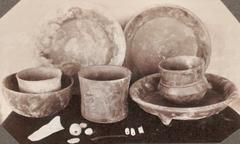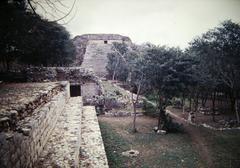Chunchucmil Visiting Hours, Tickets, and Historical Sites Guide in Yucatán, Mexico
Date: 14/06/2025
Introduction
Chunchucmil, located in the northwestern Yucatán Peninsula of Mexico, stands as a testament to the ingenuity and adaptability of the ancient Maya. Unlike more visited sites such as Chichén Itzá and Uxmal, Chunchucmil offers visitors a rare opportunity to explore a dense, urban Maya city that thrived as a commercial hub between 400–650 CE. Its remarkable urban planning, advanced water management systems, and vibrant marketplace networks set it apart historically and archaeologically. This guide provides essential details on Chunchucmil’s visiting hours, ticketing, travel tips, cultural context, and responsible tourism practices—ensuring you make the most of your visit while supporting the preservation of this unique heritage site (Yucatán government; Ancient Maya commerce; Epicure & Culture).
Table of Contents
- Introduction
- Chunchucmil: Historical and Archaeological Overview
- Visitor Information
- Guided Tours & Special Events
- Nearby Attractions
- Chunchucmil’s Urban and Economic Significance
- Cultural Context: Maya Heritage and Local Traditions
- Responsible Tourism Practices
- Frequently Asked Questions (FAQ)
- Conclusion and Call to Action
- References
Chunchucmil: Historical and Archaeological Overview
Chunchucmil is situated about 70 kilometers west of Mérida and approximately 27 kilometers from the Gulf of Mexico. Settled during the Middle Preclassic period (c. 600 BCE–250 CE), it flourished during the Classic period with an estimated population of up to 40,000 inhabitants—remarkable given its semi-arid setting and limited natural water sources (Ancient Maya commerce).
Distinctive features include:
- Double-walled fortifications and a network of sacbeob (ancient causeways)
- Chultunes (underground cisterns) and intricate water collection systems
- An unusually high population density, with a honeycomb pattern of residential compounds bounded by stone walls (Cambridge.org)
- A focus on commerce and urban life, rather than royal monuments
After its decline in the Terminal Classic period, the area remained inhabited by Maya communities, preserving its heritage through oral tradition and colonial histories (Yucatán government; Academia.edu).
Visitor Information
Visiting Hours & Admission Fees
- Open daily: 8:00 AM – 5:00 PM
- Admission: Approximately 80 MXN (about 4 USD) for adults; discounts for students, seniors, and children
- Tickets are available at the entrance; some tours include admission. Always check the official site or local centers for updates.
Getting There & Travel Tips
- By Car: About 70 km west of Mérida; parking is available near the entrance.
- Public Transport: Limited; renting a car or booking a tour is recommended.
- Roads: Generally well-maintained, but signage may be limited—use GPS or a local map.
- Preparation: Bring water, sun protection, comfortable shoes, and snacks. Early morning visits are preferable for cooler temperatures and better photography light.
Accessibility
- The site features uneven terrain and stone pathways. Some areas are accessible with moderate effort, but those with mobility challenges should plan accordingly and contact local tourism offices for support.
Facilities & Onsite Amenities
- Basic services include restrooms and shaded picnic spots.
- There is no large visitor center; refreshments and souvenirs are available from small local vendors nearby.
Guided Tours & Special Events
- Guided tours: Local guides offer in-depth explanations of the site’s history, water management, and urban planning. Booking in advance is recommended during peak seasons.
- Special events: Occasional cultural workshops and community festivals. Inquire with local tourism offices for schedules.
Nearby Attractions
- Maxcanú: A colonial town offering amenities and additional historical sites.
- Uxmal & Oxkintok: Other significant Maya ruins in the Puuc region.
- Celestún Biosphere Reserve: A renowned ecological site for birdwatching and exploring mangroves.
- Coastal towns: Halachó and Kochol, which provide local lodging and cultural experiences.
Chunchucmil’s Urban and Economic Significance
Urban Layout
The city’s core, less than 10 km², contained more than 10,000 buildings, making it one of the densest Maya centers (read.upcolorado.com). Residential groups were organized into compounds bounded by stone walls, connected by narrow walkways.
Economic and Environmental Adaptation
Chunchucmil’s proximity to coastal salt flats and its role as a trade hub for salt, obsidian, and ceramics were central to its prosperity. Innovatively designed water management systems—chultunes and aguadas—enabled the city to thrive in a dry environment (love2fly.iberia.com).
Archaeological Mapping
Modern mapping techniques, including the “fishbone” survey method, have revealed the intricate honeycomb pattern of the city’s residential layout—offering valuable insights into social organization and urban planning (Cambridge.org).
Cultural Context: Maya Heritage and Local Traditions
Maya Language and Identity
Chunchucmil, meaning “well at the base of the Chukum tree,” is still referenced in the local Maya language. The surrounding communities maintain strong Maya traditions, reflected in daily life, language, and place names (Wikipedia; Epicure & Culture).
Festivities and Handcrafts
Local festivals blend Maya and Spanish influences, featuring traditional dances such as the Jarana, vaquerías (ranch festivals), and artisanal crafts including hammocks, huipiles, and filigree jewelry (The Yucatán Times; Visit Mexico). Sampling local cuisine—such as cochinita pibil and sopa de lima—is highly recommended.
Responsible Engagement
Engaging respectfully with local Maya communities—by hiring local guides and purchasing crafts directly—ensures tourism contributes positively to the region (Springer).
Responsible Tourism Practices
- Respect the site: Stay on marked paths, do not climb on fragile structures, and avoid removing artifacts (Wikipedia).
- Support local communities: Choose community-led tours, buy local crafts, and dine at family-run eateries (Springer).
- Environmental stewardship: Minimize waste, respect flora and fauna, and conserve water.
- Cultural sensitivity: Dress modestly, ask before photographing people, and learn a few Maya or Spanish phrases (Epicure & Culture).
- Safety: The region is generally safe, but carry water, sun protection, and be mindful of midday heat (Indie Traveller).
- Accessibility: Efforts are ongoing to improve inclusivity, but terrain may be challenging for some visitors (Springer).
- Consult guidelines: For best practices, see UNWTO Responsible Tourist and AIA Tourism Guidelines.
Frequently Asked Questions (FAQ)
Q: What are Chunchucmil’s visiting hours?
A: 8:00 AM to 5:00 PM daily.
Q: How much does admission cost?
A: About 80 MXN for adults; discounts for students and seniors.
Q: Are guided tours available?
A: Yes, local guides can be hired on-site or through tour operators.
Q: How accessible is the site?
A: Terrain is uneven; some areas may be challenging for visitors with mobility issues.
Q: What should I bring?
A: Water, sun protection, comfortable shoes, snacks, and a camera.
Q: Are there nearby attractions?
A: Yes. Uxmal, Maxcanú, Celestún, and more.
Q: Is the area safe?
A: Generally yes, but standard travel precautions apply.
Conclusion and Call to Action
Chunchucmil is a must-visit destination for those interested in Maya heritage, archaeology, and Yucatán’s living culture. Its unique urban planning, economic history, and ongoing community traditions make it stand out among the region’s historical sites. Plan your visit with the information provided here—respecting the site and its people ensures this heritage endures for future generations.
Ready to explore Chunchucmil?
Download the Audiala app for guided tours and real-time travel tips, follow our social media for updates, and check out our related articles on Yucatán’s archaeological wonders!
References
- Visiting Chunchucmil: History, Tickets, Hours, and Travel Guide to Yucatán’s Ancient Maya Site, 2025, Yucatán Government (Yucatán government)
- Ancient Maya commerce: Multidisciplinary Research at Chunchucmil, 2020, Library of Congress (Ancient Maya commerce)
- Exploring Chunchucmil: Visiting Hours, Tickets, and Insights into Yucatán’s Ancient Maya City, 2017, Love2Fly Iberia (love2fly.iberia.com)
- Living in the City: Settlement Patterns and the Urban Experience at Classic Period Chunchucmil, Yucatán, Mexico, 2019, Cambridge University Press (Cambridge.org)
- Cultural Activities in Mexico Yucatan Peninsula, 2023, Epicure & Culture (Epicure & Culture)
- From Crystal Skulls to the Caste War: Intersections of Tourism, Archaeology and Heritage in the Yucatán Peninsula of Mexico, 2018, Academia.edu (Academia.edu)
- Traditions in Yucatán, 2023, Visit Mexico (Visit Mexico)
- Responsible Tourism Guidelines, UNWTO (UNWTO Responsible Tourist)
- Tourism Guidelines, Archaeological Institute of America (AIA Tourism Guidelines)
- Tourism, Archaeology and Heritage in the Yucatán Peninsula: Community Perspectives, 2019, Springer (Springer)
- The 8 Most Important Traditions and Customs of Yucatán, 2023, The Yucatán Times (The Yucatán Times)
- Yucatán Travel Guide, Indie Traveller (Indie Traveller)
- Chunchucmil, Wikipedia (Wikipedia)

